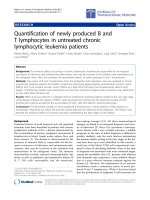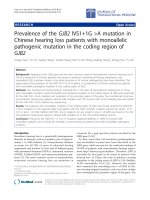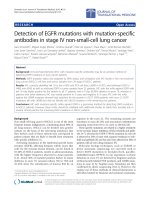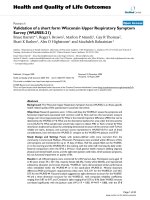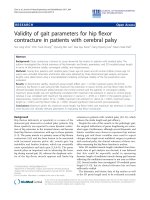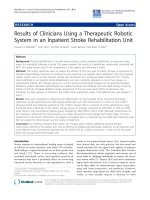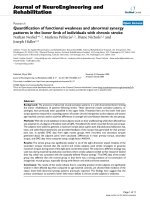báo cáo hóa học: " Robustness of digitally modulated signal features against variation in HF noise model" pdf
Bạn đang xem bản rút gọn của tài liệu. Xem và tải ngay bản đầy đủ của tài liệu tại đây (730.24 KB, 12 trang )
Hazza et al. EURASIP Journal on Wireless Communications and Networking 2011, 2011:24
/>
RESEARCH
Open Access
Robustness of digitally modulated signal features
against variation in HF noise model
Alharbi Hazza1*, Mobien Shoaib2, Alshebeili Saleh1,2 and Alturki Fahd1
Abstract
High frequency (HF) band has both military and civilian uses. It can be used either as a primary or backup
communication link. Automatic modulation classification (AMC) is of an utmost importance in this band for the
purpose of communications monitoring; e.g., signal intelligence and spectrum management. A widely used
method for AMC is based on pattern recognition (PR). Such a method has two main steps: feature extraction and
classification. The first step is generally performed in the presence of channel noise. Recent studies show that HF
noise could be modeled by Gaussian or bi-kappa distributions, depending on day-time. Therefore, it is anticipated
that change in noise model will have impact on features extraction stage. In this article, we investigate the
robustness of well known digitally modulated signal features against variation in HF noise. Specifically, we consider
temporal time domain (TTD) features, higher order cumulants (HOC), and wavelet based features. In addition, we
propose new features extracted from the constellation diagram and evaluate their robustness against the change
in noise model. This study is targeting 2PSK, 4PSK, 8PSK, 16QAM, 32QAM, and 64QAM modulations, as they are
commonly used in HF communications.
Keywords: Digital modulation features, temporal time domain features, higher order cumulants, wavelet decomposition, constellation diagram, bi-kappa noise, HF band
Introduction
Automatic modulation classification (AMC) is the process of identifying modulation type of a detected signal
without prior information. This technique has both
military and civilian applications, and is currently an
important research subject in the design of cognitive
radios [1-3]. AMC is a complex task especially in a
non co-operative environment as in high frequency
(HF) communications, where transmission is affected
by atmospheric conditions and other transmission
interferences [4].
AMC methods are grouped into two categories: likelihood based (LB) and feature based (FB) methods. LB
methods have two steps: calculating the likelihood function of the received signal for all candidate modulations,
and then using maximum likelihood ratio test (MLRT)
for decision-making. In FB methods, features are first
extracted from the received signal and then applied to a
* Correspondence:
1
Electrical Engineering Department, College of Engineering, King Saud
University, Riyadh, Saudi Arabia
Full list of author information is available at the end of the article
classifier in order to recognize the modulation type.
Most of the recent literatures use the FB methods due
to their low processing complexity and high performance [5]. For more details about AMC methods with a
comprehensive literature review, the reader is referred
to [6].
Figure 1 shows the classification task in a smart
radio. The task of the signal detection block is to identify signal transmission, while the AMC contains a feature extractor followed by a classifier. The classifier
can be based on fixed threshold as in decision tree
methods, or based on pattern recognition (PR) methods as in artificial neural networks (ANNs) and support vector machines (SVM) [7,8]. Most of the features
used in literature are based on wavelet [9,10], temporal
time domain (TTD) analysis [11-13], and higher order
cumulants (HOC) [14-16]. These features are generally
extracted under the assumption that the modulated
signals are corrupted by additive white Gaussian noise
(AWGN). Although this assumption is valid in many
communication environments, recent studies show that
HF noise changes between AWG and bi-kappa
© 2011 Hazza et al; licensee Springer. This is an Open Access article distributed under the terms of the Creative Commons Attribution
License ( which permits unrestricted use, distribution, and reproduction in any medium,
provided the original work is properly cited.
Hazza et al. EURASIP Journal on Wireless Communications and Networking 2011, 2011:24
/>
Page 2 of 12
Intercepted signal
Signal Detection
Feature Extraction
Classifier
Automatic Modulation
Classification Process
M Demodulator
Demodulated
signal
Figure 1 AMC based receiver architecture using feature based methods.
distributions [17,18]. The effect of these two noise distributions has been taken into account during the
design of the AMC algorithms proposed in [19]. The
work shows that the change in noise model affects the
classification performance, especially at low signal-tonoise ratio (SNR). Therefore, the robustness of commonly used features against variation in noise models
needs to be investigated so that more reliable AMC
algorithms can be designed for HF signals.
In this paper, we first examine the effect of Gaussian
and bi-kappa noise models on wavelet, HOC, and TTD
features, when these features are considered for the
classification of single carrier modulations commonly
used in HF band: 2PSK, 4PSK, 8PSK, 16QAM,
32QAM, and 64QAM [20]. Second, we propose new
features based on maximum dissimilarity measures
(MDM) in constellation diagram and evaluate their
robustness against the change in noise model. Note
that the contribution of this article is pertaining to the
features extraction stage; hence the results obtained
are independent of the classifier being used. However,
these results will greatly serve the classifier design
stage, as this stage can be based on features that are
robust with respect to noise models.
The organization of the article is as follows. ‘Signal
model’ and ‘Noise model’ sections present signal and
channel noise models, respectively. ‘Commonly used signal features’ section introduces the TTD, HOC, and
wavelet based features. ‘Proposed features’ section presents the proposed features. ‘Simulation results’ section
presents results showing the robustness of the different
features against the variation in noise model. ‘Conclusion’ section presents concluding remarks.
Signal model
The general form of received signal encompassing all
modulation schemes under consideration is given by [21]:
r(t) = Re C(t)ej2π fc t + n(t)
(1)
where C(t)is the complex envelope of modulated signal, n(t) is band limited noise, fc is the carrier frequency,
and Re{} denotes the real part. The complex envelope is
characterized by the constellation points C k , signal
power E, and pulse shaping functionp(t). For Nsymbols
with periodicity T, the general form of complex envelope can be expressed as:
C(t) =
√
E
N
k
Ck p(t − kT)
(2)
For MPSK modulation, Ck Î {e-j2πm/M}, where m = 0,
1, ..., m-1. For MQAM modulations, Ck Ỵ ak + jbk, m =
0, 1, ..., (M)1/2/2, and
Noise model
Noise model assumed in most of the research related to
AMC is AWGN. This research focuses on AMC in HF
band, where the AWGN assumption no longer remains
valid for all transmission times [17,18]. Instead, the
noise varies between AWGN and bi-kappa distributions.
Hazza et al. EURASIP Journal on Wireless Communications and Networking 2011, 2011:24
/>
Page 3 of 12
Figure 2 Probability distribution function of bi-kappa noise for different values of parameters.
The bi-Kappa distribution is characterized by the following probability distribution function:
⎧
−k
⎪ 1
x2
⎪
⎪ √
k>0
⎪
⎪ 2 πσ 1 + kσ 2
⎪
⎪
⎨ 1
k=0
√
(3)
p(x, k) =
⎪ 2 πσ
⎪
⎪
k
⎪ 1
⎪
x2
⎪
⎪ √
1− 2
k<0
⎩
kσ
2 πσ
where s and k are the shaping parameter and tuning
factor, respectively. Practical values of these parameters
are s = 46, k = 1.1, and s = 20, k = 1 [17]. Figure 2
shows the probability distribution function, p(x, k), for
different values of s and k. The figure shows that
decreasing the shaping parameter produces a shaper
peak and that the bi-kappa distribution approaches the
AWG distribution when the tuning parameter is
increased. In this work, the parameters of bi-kappa distribution are set to s = 20, k = 1.
A more realistic noise model can be constructed by
passing the bi-kappa noise through a band-limiting filter. The bandwidth of this filter is set to 8gs where gs is
the symbol rate. This filter is practically used to minimize the transmission bandwidth. Figure 3 shows the
constellation diagram of an intercepted 2PSK signal
down converted to baseband for different SNR. This figure shows clearly the spiky nature of bi-kappa noise as
compared to AWGN, especially at low SNR.
TTD features
The variations in modulated waveforms can be
described by three instantaneous values: frequency,
phase, and amplitude [11,12]. All values related to
these variations are defined as the TTD features. Two
features will be investigated in our study. The first feature is the standard deviation of the absolute value of
the centered non-linear component of the instantaneous phase defined as
⎤
⎡
σap =
1⎣
L
⎡
2
ϕNL (i)⎦ − ⎣
a(i)t0 tth
⎤2
1
L
| ϕNL (i)| ⎦
(4)
a(i)t0 tth
where jNL is the centered non-linear component of
the instantaneous phase, t th is the threshold value of
the non weak signal, L is the number of samples in
jNL.
The second feature is the standard deviation of the
absolute value of the normalized-centered instantaneous
amplitude; that is,
σaa =
1
Ns
Ns
i=1
2
Ns
| acn (i)|
a2 (i) −
cn
(5)
i=1
where Ns is the number of samples, acn = a/ma-1,a is
the absolute value of the analytic form of the received
signal, and ma is its sample mean value.
HOC features
Commonly used signal features
This section gives the general formulas and description
of commonly used signal features. Specifically, we consider the TTD, HOS, and wavelet based features.
The HOC are used to extract hidden information from
non-Gaussian signals. In presence of AWGN, all the
HOC are zero for orders greater than two. This makes
these features attractive to classify modulated signals
Hazza et al. EURASIP Journal on Wireless Communications and Networking 2011, 2011:24
/>
Page 4 of 12
Figure 3 Effect of HF noise models on the intercepted signals.
corrupted by AWGN. Fourth and sixth HOC considered
in this study are defined as follows [14-16]:
C42 = M42 − |M20 |2 − 2M21 2
(6)
C63 = M63 − 9C42 C21 − 6C21 3
(7)
where C21 is the average power and Mpq is the joint
moment. The later can be calculated for any values of p
and q using the following equation:
Mpq = E xp−q (x∗)q
(8)
where x* denotes complex conjugate and E{} is the
expectation operation. Table 1 shows the theoretical
cumulants for the considered modulation schemes.
Wavelet features
Wavelet transform preserves the time information while
providing the frequency information of an analyzed signal. This makes it a good candidate for AMC. As shown
in Figure 4, features extraction using wavelet transform
passes through three steps: wavelet decomposition using
Haar mother waveform, median filtering, and finally calculation of standard deviation [22]. Robustness of
Table 1 Theoretical values of HOC for digital modulations
Signal
C42
C63
2PSK
-2
13
4PSK
-1
4
8PSK
-1
4
16QAM
-0.68
2.08
32QAM
-0.69
-0.62
1.8
Proposed features
The PSK and QAM modulations are represented by a
constellation diagram in which the modulation symbols
are depicted in terms of phase and amplitude variations.
This diagram is extracted from the analytic form of the
IF signal by multiplication with the complex conjugate
of the carrier frequency. Many AMC algorithms are
designed using features based on constellation diagram.
These algorithms use different classification techniques
that include maximum likelihood [23], genetic
algorithms [24,25], modified Chi-squared test [26], and
subtractive clustering [27]. In this article, we propose a
different use of constellation diagram by extracting features based on maximum dissimilarity measures
(MDM), firstly to distinguish between different modulation types, such as QAM and PSK signals, and secondly
to find the order of a particular modulation. MDM features depend on calculating the dissimilarity between
different constellation diagrams after signals normalization. That is, features are extracted from the distance
(or dissimilarity measures) between the complex envelope of the received signal and set of reference constellation points for a particular modulation scheme. These
reference constellation points are defined by their amplitudes and phases [21]. MDM are computed after normalizing both the received and reference constellation
points to their mean values. The dissimilarity function is
defined as [28]:
2.11
64QAM
wavelet features against noise model has been tested at
level three and four.
dmax (x, p) = max (d(x, p))
x∈x,p∈p
(9)
Hazza et al. EURASIP Journal on Wireless Communications and Networking 2011, 2011:24
/>
Received
Signal
Wavelet Decomposition
Level (4) and (3)
Extracted
Features
Page 5 of 12
|
|
Median
Filtering
Standard Deviation
Figure 4 Steps for wavelet features extraction.
where d is the Euclidian distance between the complex
envelope of intercepted signal × and reference constellation points p. For feature extraction, the signal × is randomly generated at a particular SNR. A dissimilarity
vector d, whose entries are the distance between a randomly generated constellation point of x and M reference
constellation points p, can be obtained. The element of
maximum value of vector d is averaged over several independent runs, and then selected as the desired feature. In
practice, the mean and/or standard deviation of dmax(x,
p) will have values based on the noise level.
Table 2 shows five proposed features related to the
MDM, each of which is responsible for discriminating a
specific modulation type or modulation order. As shown
in Table 1, the first feature d1 is used to discriminate
between QAM and PSK signals, while d2 is used to discriminate between 2PSK and other PSK signals of higher
orders. For further details see Table 2.
Figures 5, 6, 7, 8, and 9 show relevant variations of
proposed features as a function of SNR. The results
are averaged over 100 independent realizations and
displayed for AWGN. Clearly, these figures show that
the proposed features have potential applications in
AMC, as they can be used in conjunction with decision tree or machine learning techniques for signal
classification.
Effect of noise model on the proposed features will be
discussed in the next section.
Simulation results
To evaluate the robustness of presented features, all the
modulations schemes under test were generated in presence of band-limited AWGN and bi-kappa noise,
where the bandwidth of the band-limiting filter is 8gs;
this process is practically used to avoid high bandwidth
Table 2 Proposed features
Feature
p
x
Suggested use
d1 = std(dmax(x, p))
8PSK
2PSK
4PSK
8PSK
16QAM
32QAM
64QAM
Discrimination between MPSK and MQAM
d2 = meandmax(x, p))
2PSK
2PSK
4PSK
8PSK
Discrimination between 2PSK and (4PSK, 8PSK)
d3 = mean(dmax(x, p))
4PSK
4PSK
8PSK
Discrimination between 4PSK and 8PSK
d4 = mean(dmax(x, p))
16QAM
16QAM
32QAM
64QAM
Discrimination between 16QAM and (32QAM, 64QAM)
d5 = std(dmax(x, p))
64QAM
32QAM
64QAM
Discrimination between 64QAM and 32MQAM
Hazza et al. EURASIP Journal on Wireless Communications and Networking 2011, 2011:24
/>
Page 6 of 12
1.4
2PSK
4PSK
8PSK
16QAM
32QAM
64QAM
1.2
1
d1
0.8
0.6
0.4
0.2
0
0
5
10
SNR
15
20
25
30
Figure 5 d1 for the discrimination between MPSK and MQAM signals.
3.2
2PSK
4PSK
8PSK
3
d2
2.8
2.6
2.4
2.2
-5
0
5
10
SNR
Figure 6 d2 for the discrimination between 2PSK and higher PSK signals.
15
20
25
30
Hazza et al. EURASIP Journal on Wireless Communications and Networking 2011, 2011:24
/>
Page 7 of 12
3.05
4PSK
8PSK
3
d3
2.95
2.9
2.85
2.8
2.75
-5
0
5
10
SNR
15
20
25
30
Figure 7 d3 for the discrimination between 4PSK and 8PSK signals.
16QAM
32QAM
64QAM
d4
3.75
3.7
3.65
3.6
0
5
10
15
SNR
Figure 8 d4for the discrimination between 16QAM and higher QAM signals.
20
25
30
Hazza et al. EURASIP Journal on Wireless Communications and Networking 2011, 2011:24
/>
Page 8 of 12
1
32QAM
0.95
64QAM
0.9
d5
0.85
0.8
0.75
0.7
0.65
-5
0
5
10
SNR
15
20
25
30
Figure 9 d5 for the discrimination between 32QAM and 64QAM.
transmission [13]. SNR is adjusted by multiplying the
output noise by the following factor:
Rsnr =
E −SNR/20
10
N0
(10)
where E, N0, SNR are the signal power, noise power,
and desired SNR, respectively. All constellation points
are normalized to zero mean and unity variance. The
simulation parameters are given in Table 3.
For evaluation purposes, we measure the absolute
value of the percentage deviation of each feature when
noise model is changed from AWGN to bi-kappa. This
percentage is evaluated using SNR ranging between 0
and 30 dB, and is defined as follows
η=
FAWGN − FBi - kappa
× 100
FAWGN
(11)
where FAWGN and FBi-kappa are the values of feature
under consideration computed in the presence of
AWGN and bi-kappa noise, respectively, at a particular
Table 3 Simulation parameters
Parameter
Value
Carrier frequency
fc = 24 kHz
Symbol rate
rs = 2400 Hz
Sampling rate
fs = 153.6 kHz
No. of symbols for testing
512
Total number of samples
32768
SNR. Figures 10, 11, 12, 13, 14, and 15 show the results,
averaged over 100 independent realizations, for the following set of modulations: 2PSK, 4PSK, 8PSK, 16QAM,
32QAM, and 64QAM.
The above figures show that at SNR <10 dB, TTD and
MDM are more robust than HOC against the change in
HF noise model. It is true in general that h decreases as
SNR increases. However, for MPSK signals, the instantaneous amplitude feature has lower deviation for SNR
<30 dB. This is intuitively not surprising because the
difference between F AWGN and F bi-kappa relative to
FAWGN in this SNR range is smaller than that of higher
SNR values. Another observation is that the wavelet
based features have maintained almost the same values
of h for all considered modulations. In addition, the
proposed MDM have shown excellent performance in
the sense that they have the lowest deviation as compared to other features.
Conclusions
In this article, we have investigated the robustness of
four features categories for the classification of digitally
modulated signals in the presence of HF noise models;
AWGN and bi-kappa noise. Specifically, the TTD, HOC,
wavelets, and MDM features are considered, where the
last feature is proposed in this work. It has been shown
through computer simulations that HOC are sensitive to
the change in noise model especially at low SNR (<10
dB), while TTD, wavelets, and MDM show good robustness (h < 25%) in the investigated range of SNR. Note
Hazza et al. EURASIP Journal on Wireless Communications and Networking 2011, 2011:24
/>
Figure 10 Features deviations computed from 2PSK signal.
Figure 11 Features deviations computed from 4PSK signals.
Page 9 of 12
Hazza et al. EURASIP Journal on Wireless Communications and Networking 2011, 2011:24
/>
Page 10 of 12
Figure 12 Features deviations computed from 8PSK signals.
that the proposed MDM features have the lowest values
of h, i.e., highest robustness against variation in noise
model, as compared to other features. The results of
this article have potential values for the design of a classifier, as they identify the features that of higher
Figure 13 Features deviations computed from 16QAM signals.
robustness with respect to HF noise models. Note that
the performance of an AMC designed under the
assumption of AWGN noise model cannot be ensured
when considering HF communications. Classifiers
employing features sensitive to variation in noise model
Hazza et al. EURASIP Journal on Wireless Communications and Networking 2011, 2011:24
/>
Figure 14 Features deviations computed from 32QAM signal.
Figure 15 Features deviations computed from 64QAM modulation.
Page 11 of 12
Hazza et al. EURASIP Journal on Wireless Communications and Networking 2011, 2011:24
/>
should take this variation into consideration. For example, SVM or ANNs based classifiers need to be designed
by training with signals corrupted by both HF noise
models.
List of Abbreviations
AMC: Automatic modulation classification; ANNs: artificial neural networks;
AWGN: additive white Gaussian noise; FB: feature based; HF: high frequency;
HOC: higher order cumulants; LB: likelihood based; MDM: maximum
dissimilarity measures; MLRT: maximum likelihood ratio test; PR: pattern
recognition; SNR: signal-to-noise ratio; SVM: support vector machines; TTD:
temporal time domain.
Acknowledgements
This work was supported by a grant (No. 08-ELE 263-2) from the unit of
science and Technology at King Saud University.
Author details
1
Electrical Engineering Department, College of Engineering, King Saud
University, Riyadh, Saudi Arabia 2Prince Sultan Advanced Technologies
Research Institute/STC-Chair, King Saud University, Riyadh, Saudi Arabia
16.
17.
18.
19.
20.
21.
22.
23.
24.
Competing interests
The authors declare that they have no competing interests.
Received: 21 October 2010 Accepted: 29 June 2011
Published: 29 June 2011
25.
26.
References
1. P Jain, RM Buehrer, Implementation of adaptive modulation on the Sunrise
software radio. in The Proceedings of the 45th Midwest Symposium on
Circuits and Systems, 3, III–405–III-408, 4–7, August 2002
2. B Le, T Rondeau, D Maldonado, Modulation identification using neural
networks for cognitive radios. in Proceedings of SDR05 Technical Conference,
(Phoenix, AZ, 2005)
3. K Kim, IA Akbar, KK Bae, J Um, CM Spooner, JH Reed, Cyclostationary
approaches to signal detection and classification in cognitive radio. in
Proceedings of IEEE Dynamic Spectrum Access Nets. 212–215 (2007)
4. N Maslim, HF Communications: A Systems Approach. (CRC Press, London,
1987)
5. C Le Martret, D Boitea, Ageneral maximum likelihood classifier for
modulation classification. in Proceedings of ICASSP, 4, 2165–2168 (1998)
6. OA Dobre, A Abdi, Y Bar-Ness, W Su, Survey of automatic modulation
classification techniques: classical approaches and new trends. IET Commun.
1, 137–156 (2007)
7. MLD Wong, AK Nandi, Automatic digital modulation recognition using
artificial neural network and genetic algorithm. Signal Process. 351–365
(2004)
8. P Cheol-Sun, J Won, N Sun-Phil, Automatic modulation recognition using
support vector machine in software radio applications. in Proceedings of
ICACT 2007, Gangwon-Do, 1, 9–12, February 2007
9. K Maliatsos, S Vassaki, Ph Constantinou, Interclass and intraclass modulation
recognition using the wavelet transformation. in Proc PIMRC 2007, Athens,
1–5, September 2007
10. M Ling-Ling, S Xiu-jie, An improved algorithm of modulation classification
for digital communication signals based on wavelet transform. in
Proceedings of ICWAPR 07, Beijing, 3, 1226–1231, November 2007
11. Z Ye, G Memik, J Grosspietsch, Digital modulation classification using
temporal waveform features for cognitive radios. in Proceedings of PIMRC
2007, Athens, 1–5, September 2007
12. AK Nandi, EE Azzouz, Algorithms for automatic modulation recognition of
communication signals. IEEE Trans Commun. 46, 431–436 (1998)
13. EE Azzouz, AK Nandi, Automatic Modulation Recognition of Communication
Signals, (Kluwer Academic, Norwell 1996)
14. T He, XR Jing, Modulation classification using ARBF networks. in Proceedings
of ICSP, Beijing, China, 1809–18120, August 2004
15. L Peng, W Fuping, W Zanji, Algorithm for modulation recognition based on
high-order cumulants and subspace decomposition. in Proceedings of 8th
27.
28.
Page 12 of 12
International Conference on Signal Processing, Beijing, 3, 16–20, November
2006
OA Dobre, A Abdi, Y Bar-Ness, W Su, Selection combining for modulation
recognition in fading channels. in Proceedings of IEEE MILCOM. Atlantic City,
US, 2499–2505 (2005)
J Giesbrecht, R Clarke, D Abbott, An imperical study of the probability
density function of HF noise. Fluct Noise Lett. 6(2), L117–L123 (2006)
J Giesbrecht, An empirical study of HF noise near Adelaide Australia. in IET
11th International Conference on Ionospheric Radio Systems and Techniques.
Edinburgh, UK, 310–314, 28–30 April 2010
H Alharbi, S Mobien, S Alshebeili, F Alturki, Classification of digitally
modulated signals in presence of non-Gaussian HF noise. in Proceedings of
7th ISWCS, Yourk, UK, September 2010, (in press)
R Prosch, Technical Handbook For Radio Monitoring I, (Books on Demand
GmbH, Norderstedt, Germany, 2007)
JG Proakis, Digital Communications, (McGraw-Hill, New York, 2001)
P Cheol-Sun, C Jun-Ho, N Sun-Phil, J Won, Automatic modulation
recognition of digital signals using wavelet features and SVM. in Proceedings
of 10th ICACT. Gangwon-Do, 1, 387–390, February 2008
B Mobaseri, Constellation shape as a robust signature for digital modulation
recognition. in Military Communications Conference Proceedings, MILCOM
IEEE, 1, 442–446 (1999)
N Ahmadi, B Reza, Modulation classification of QAM and PSK from their
constellation using Genetic Algorithm and hierarchical clustering. in 3d IEEE
International Conference on Information & Communication Technologies: from
Theory to Applications, ICTTA’08. Umayyad Palace, Damascus, Syria, 7–11,
April 2008
N Ahmadi, B Reza, A template matching approach to classification of QAM
modulation using genetic algorithm. Signal Process Int J. 3(5), 95–109
(2009)
W Kam-Tim, K Chi-Wah, Clustering based distribution fitting algorithm for
automatic modulation recognition. ISCC’ 2007. pp. 13–18
Y Changyi, L Bingbing, L Yanling, Modulation classification of MQAM signals
from their constellation using clustering. in 2010 Second International
Conference on Communication Software and Networks, pp. 303–306
S Theodoridis, K Koutroumbas, Pattern Recognition, 4th edn. (Elsevier Inc.,
Canada 2009)
doi:10.1186/1687-1499-2011-24
Cite this article as: Hazza et al.: Robustness of digitally modulated signal
features against variation in HF noise model. EURASIP Journal on Wireless
Communications and Networking 2011 2011:24.
Submit your manuscript to a
journal and benefit from:
7 Convenient online submission
7 Rigorous peer review
7 Immediate publication on acceptance
7 Open access: articles freely available online
7 High visibility within the field
7 Retaining the copyright to your article
Submit your next manuscript at 7 springeropen.com



